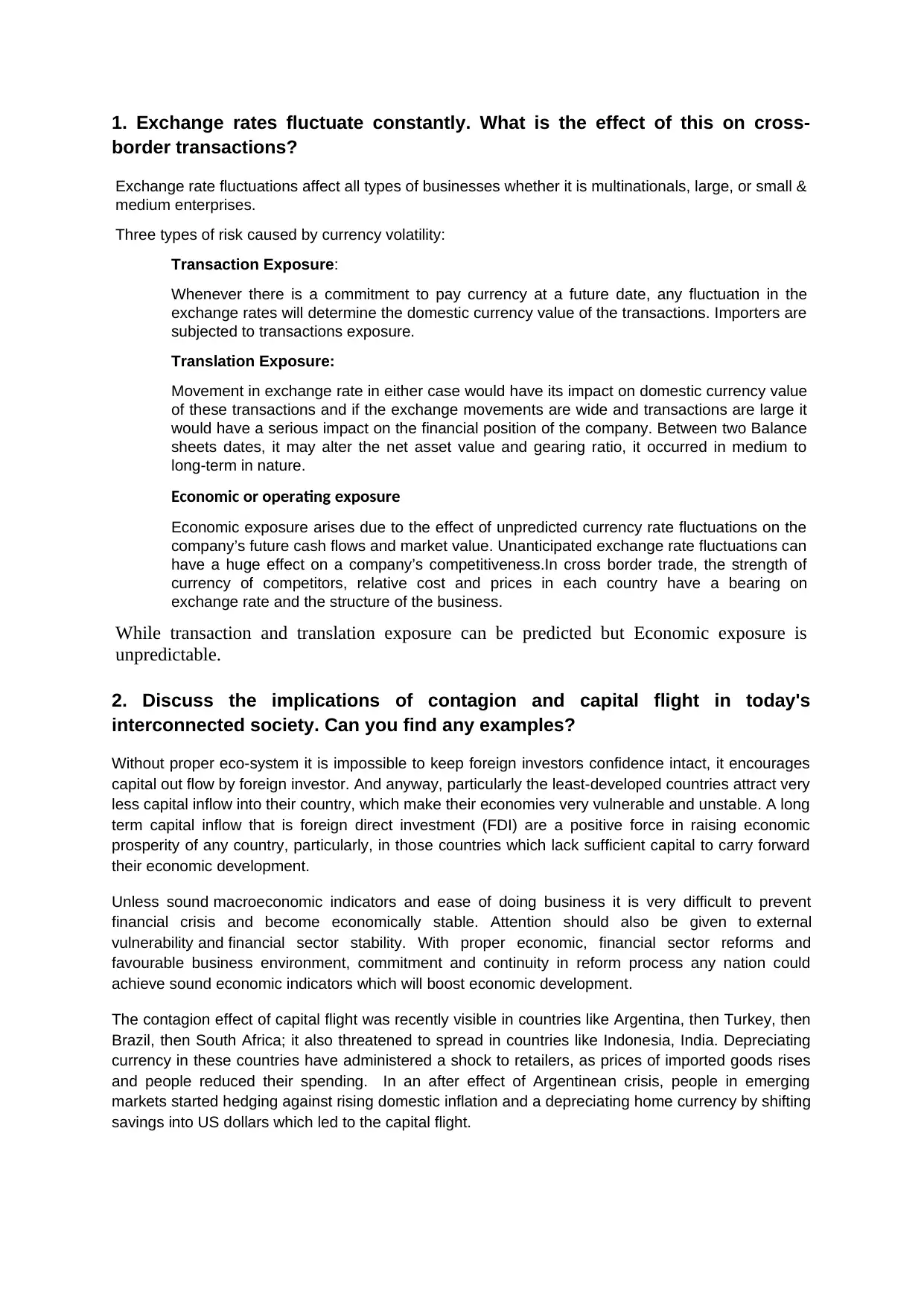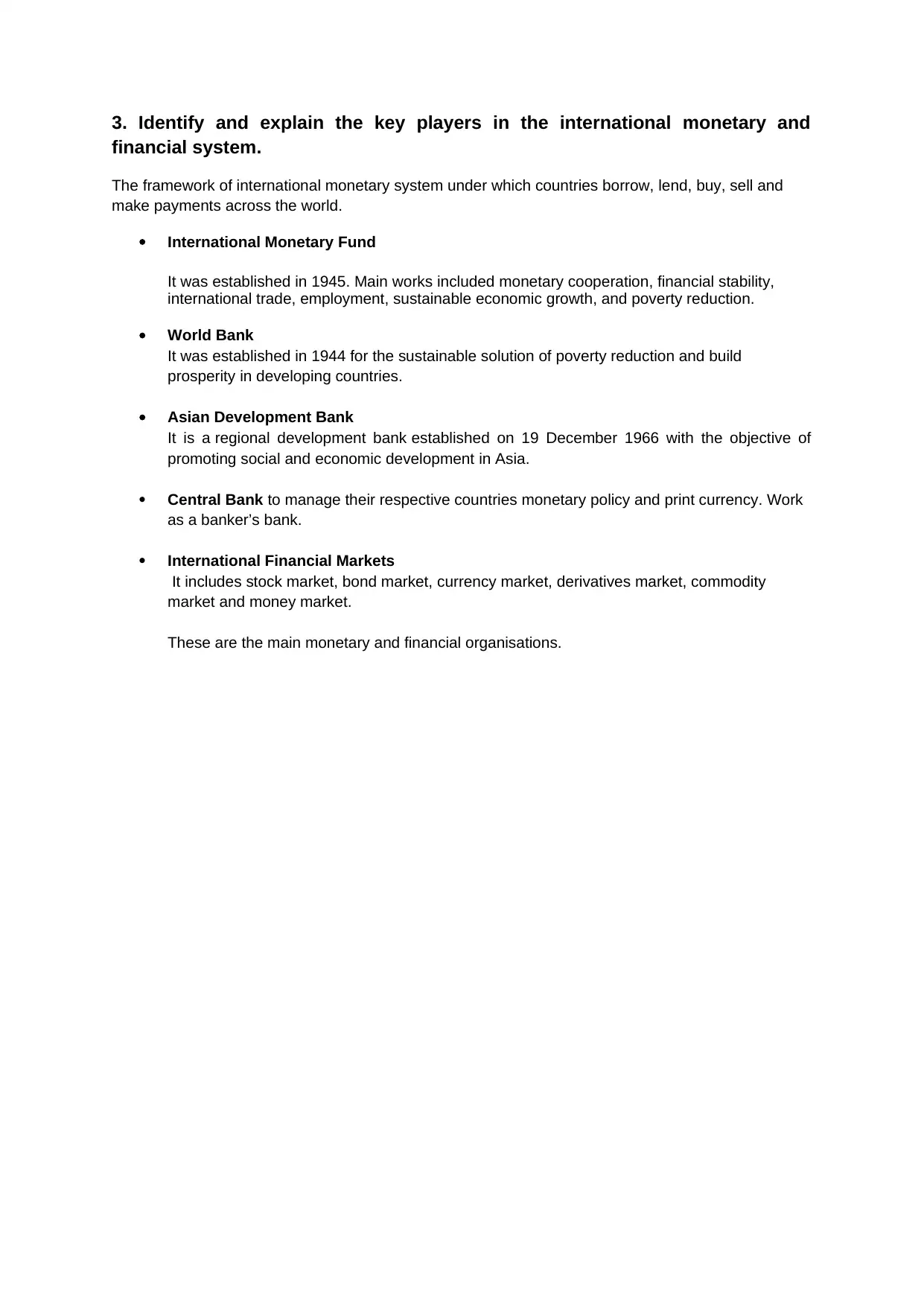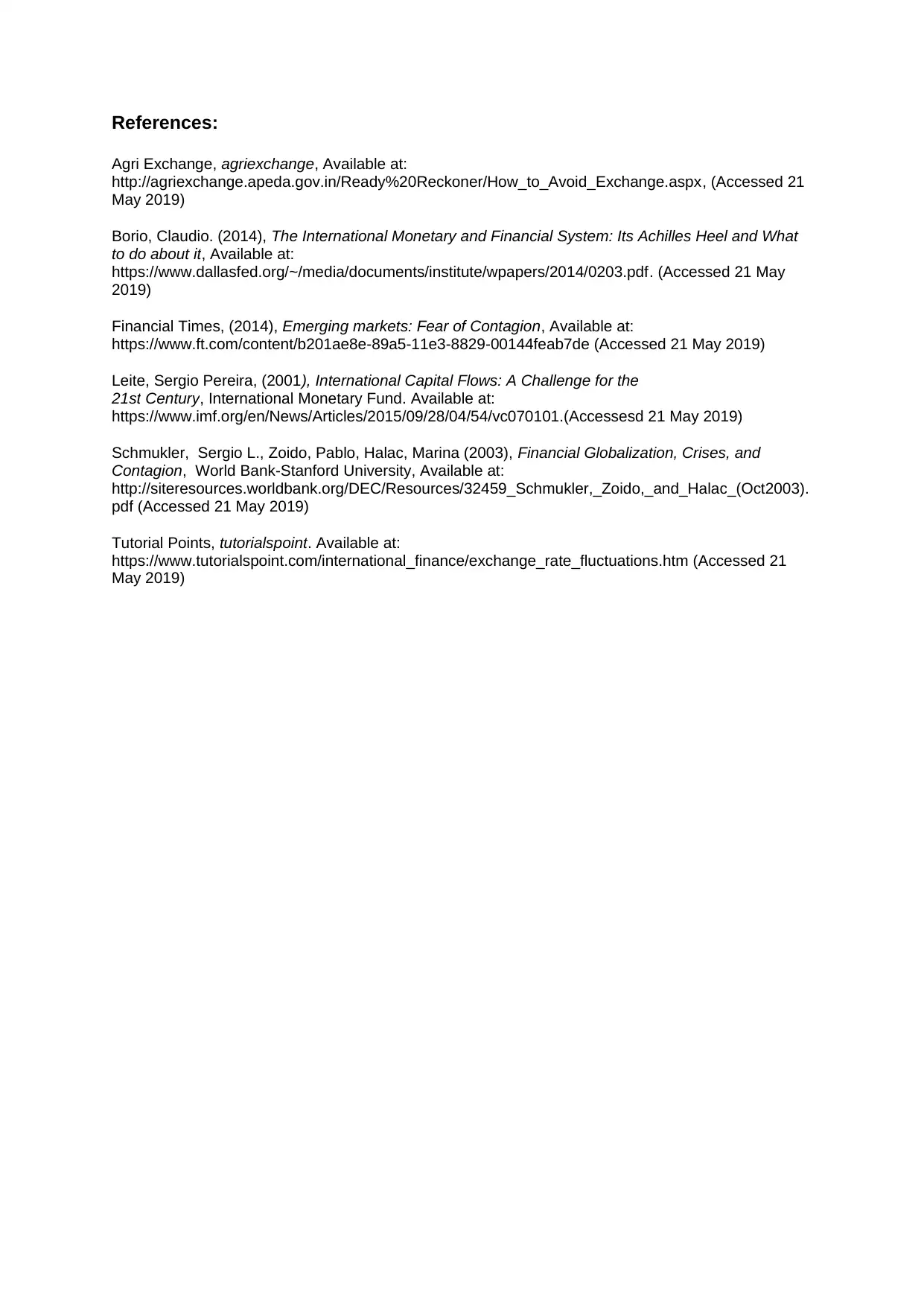Impact of Exchange Rates, Contagion, and Financial Systems
VerifiedAdded on 2022/11/24
|3
|876
|473
Homework Assignment
AI Summary
This assignment analyzes the effects of exchange rate fluctuations on cross-border transactions, highlighting transaction, translation, and economic exposures. It discusses the implications of contagion and capital flight in an interconnected society, providing examples from recent financial crises in countries like Argentina, Turkey, and Brazil, and explains how depreciating currencies led to capital flight. The assignment also identifies and explains the key players in the international monetary and financial system, including the International Monetary Fund, World Bank, Asian Development Bank, central banks, and international financial markets. References are provided to support the analysis.

1. Exchange rates fluctuate constantly. What is the effect of this on cross-
border transactions?
Exchange rate fluctuations affect all types of businesses whether it is multinationals, large, or small &
medium enterprises.
Three types of risk caused by currency volatility:
Transaction Exposure:
Whenever there is a commitment to pay currency at a future date, any fluctuation in the
exchange rates will determine the domestic currency value of the transactions. Importers are
subjected to transactions exposure.
Translation Exposure:
Movement in exchange rate in either case would have its impact on domestic currency value
of these transactions and if the exchange movements are wide and transactions are large it
would have a serious impact on the financial position of the company. Between two Balance
sheets dates, it may alter the net asset value and gearing ratio, it occurred in medium to
long-term in nature.
Economic or operating exposure
Economic exposure arises due to the effect of unpredicted currency rate fluctuations on the
company’s future cash flows and market value. Unanticipated exchange rate fluctuations can
have a huge effect on a company’s competitiveness.In cross border trade, the strength of
currency of competitors, relative cost and prices in each country have a bearing on
exchange rate and the structure of the business.
While transaction and translation exposure can be predicted but Economic exposure is
unpredictable.
2. Discuss the implications of contagion and capital flight in today's
interconnected society. Can you find any examples?
Without proper eco-system it is impossible to keep foreign investors confidence intact, it encourages
capital out flow by foreign investor. And anyway, particularly the least-developed countries attract very
less capital inflow into their country, which make their economies very vulnerable and unstable. A long
term capital inflow that is foreign direct investment (FDI) are a positive force in raising economic
prosperity of any country, particularly, in those countries which lack sufficient capital to carry forward
their economic development.
Unless sound macroeconomic indicators and ease of doing business it is very difficult to prevent
financial crisis and become economically stable. Attention should also be given to external
vulnerability and financial sector stability. With proper economic, financial sector reforms and
favourable business environment, commitment and continuity in reform process any nation could
achieve sound economic indicators which will boost economic development.
The contagion effect of capital flight was recently visible in countries like Argentina, then Turkey, then
Brazil, then South Africa; it also threatened to spread in countries like Indonesia, India. Depreciating
currency in these countries have administered a shock to retailers, as prices of imported goods rises
and people reduced their spending. In an after effect of Argentinean crisis, people in emerging
markets started hedging against rising domestic inflation and a depreciating home currency by shifting
savings into US dollars which led to the capital flight.
border transactions?
Exchange rate fluctuations affect all types of businesses whether it is multinationals, large, or small &
medium enterprises.
Three types of risk caused by currency volatility:
Transaction Exposure:
Whenever there is a commitment to pay currency at a future date, any fluctuation in the
exchange rates will determine the domestic currency value of the transactions. Importers are
subjected to transactions exposure.
Translation Exposure:
Movement in exchange rate in either case would have its impact on domestic currency value
of these transactions and if the exchange movements are wide and transactions are large it
would have a serious impact on the financial position of the company. Between two Balance
sheets dates, it may alter the net asset value and gearing ratio, it occurred in medium to
long-term in nature.
Economic or operating exposure
Economic exposure arises due to the effect of unpredicted currency rate fluctuations on the
company’s future cash flows and market value. Unanticipated exchange rate fluctuations can
have a huge effect on a company’s competitiveness.In cross border trade, the strength of
currency of competitors, relative cost and prices in each country have a bearing on
exchange rate and the structure of the business.
While transaction and translation exposure can be predicted but Economic exposure is
unpredictable.
2. Discuss the implications of contagion and capital flight in today's
interconnected society. Can you find any examples?
Without proper eco-system it is impossible to keep foreign investors confidence intact, it encourages
capital out flow by foreign investor. And anyway, particularly the least-developed countries attract very
less capital inflow into their country, which make their economies very vulnerable and unstable. A long
term capital inflow that is foreign direct investment (FDI) are a positive force in raising economic
prosperity of any country, particularly, in those countries which lack sufficient capital to carry forward
their economic development.
Unless sound macroeconomic indicators and ease of doing business it is very difficult to prevent
financial crisis and become economically stable. Attention should also be given to external
vulnerability and financial sector stability. With proper economic, financial sector reforms and
favourable business environment, commitment and continuity in reform process any nation could
achieve sound economic indicators which will boost economic development.
The contagion effect of capital flight was recently visible in countries like Argentina, then Turkey, then
Brazil, then South Africa; it also threatened to spread in countries like Indonesia, India. Depreciating
currency in these countries have administered a shock to retailers, as prices of imported goods rises
and people reduced their spending. In an after effect of Argentinean crisis, people in emerging
markets started hedging against rising domestic inflation and a depreciating home currency by shifting
savings into US dollars which led to the capital flight.
Paraphrase This Document
Need a fresh take? Get an instant paraphrase of this document with our AI Paraphraser

3. Identify and explain the key players in the international monetary and
financial system.
The framework of international monetary system under which countries borrow, lend, buy, sell and
make payments across the world.
International Monetary Fund
It was established in 1945. Main works included monetary cooperation, financial stability,
international trade, employment, sustainable economic growth, and poverty reduction.
World Bank
It was established in 1944 for the sustainable solution of poverty reduction and build
prosperity in developing countries.
Asian Development Bank
It is a regional development bank established on 19 December 1966 with the objective of
promoting social and economic development in Asia.
Central Bank to manage their respective countries monetary policy and print currency. Work
as a banker’s bank.
International Financial Markets
It includes stock market, bond market, currency market, derivatives market, commodity
market and money market.
These are the main monetary and financial organisations.
financial system.
The framework of international monetary system under which countries borrow, lend, buy, sell and
make payments across the world.
International Monetary Fund
It was established in 1945. Main works included monetary cooperation, financial stability,
international trade, employment, sustainable economic growth, and poverty reduction.
World Bank
It was established in 1944 for the sustainable solution of poverty reduction and build
prosperity in developing countries.
Asian Development Bank
It is a regional development bank established on 19 December 1966 with the objective of
promoting social and economic development in Asia.
Central Bank to manage their respective countries monetary policy and print currency. Work
as a banker’s bank.
International Financial Markets
It includes stock market, bond market, currency market, derivatives market, commodity
market and money market.
These are the main monetary and financial organisations.

References:
Agri Exchange, agriexchange, Available at:
http://agriexchange.apeda.gov.in/Ready%20Reckoner/How_to_Avoid_Exchange.aspx, (Accessed 21
May 2019)
Borio, Claudio. (2014), The International Monetary and Financial System: Its Achilles Heel and What
to do about it, Available at:
https://www.dallasfed.org/~/media/documents/institute/wpapers/2014/0203.pdf. (Accessed 21 May
2019)
Financial Times, (2014), Emerging markets: Fear of Contagion, Available at:
https://www.ft.com/content/b201ae8e-89a5-11e3-8829-00144feab7de (Accessed 21 May 2019)
Leite, Sergio Pereira, (2001), International Capital Flows: A Challenge for the
21st Century, International Monetary Fund. Available at:
https://www.imf.org/en/News/Articles/2015/09/28/04/54/vc070101.(Accessesd 21 May 2019)
Schmukler, Sergio L., Zoido, Pablo, Halac, Marina (2003), Financial Globalization, Crises, and
Contagion, World Bank-Stanford University, Available at:
http://siteresources.worldbank.org/DEC/Resources/32459_Schmukler,_Zoido,_and_Halac_(Oct2003).
pdf (Accessed 21 May 2019)
Tutorial Points, tutorialspoint. Available at:
https://www.tutorialspoint.com/international_finance/exchange_rate_fluctuations.htm (Accessed 21
May 2019)
Agri Exchange, agriexchange, Available at:
http://agriexchange.apeda.gov.in/Ready%20Reckoner/How_to_Avoid_Exchange.aspx, (Accessed 21
May 2019)
Borio, Claudio. (2014), The International Monetary and Financial System: Its Achilles Heel and What
to do about it, Available at:
https://www.dallasfed.org/~/media/documents/institute/wpapers/2014/0203.pdf. (Accessed 21 May
2019)
Financial Times, (2014), Emerging markets: Fear of Contagion, Available at:
https://www.ft.com/content/b201ae8e-89a5-11e3-8829-00144feab7de (Accessed 21 May 2019)
Leite, Sergio Pereira, (2001), International Capital Flows: A Challenge for the
21st Century, International Monetary Fund. Available at:
https://www.imf.org/en/News/Articles/2015/09/28/04/54/vc070101.(Accessesd 21 May 2019)
Schmukler, Sergio L., Zoido, Pablo, Halac, Marina (2003), Financial Globalization, Crises, and
Contagion, World Bank-Stanford University, Available at:
http://siteresources.worldbank.org/DEC/Resources/32459_Schmukler,_Zoido,_and_Halac_(Oct2003).
pdf (Accessed 21 May 2019)
Tutorial Points, tutorialspoint. Available at:
https://www.tutorialspoint.com/international_finance/exchange_rate_fluctuations.htm (Accessed 21
May 2019)
⊘ This is a preview!⊘
Do you want full access?
Subscribe today to unlock all pages.

Trusted by 1+ million students worldwide
1 out of 3
Related Documents
Your All-in-One AI-Powered Toolkit for Academic Success.
+13062052269
info@desklib.com
Available 24*7 on WhatsApp / Email
![[object Object]](/_next/static/media/star-bottom.7253800d.svg)
Unlock your academic potential
Copyright © 2020–2025 A2Z Services. All Rights Reserved. Developed and managed by ZUCOL.





